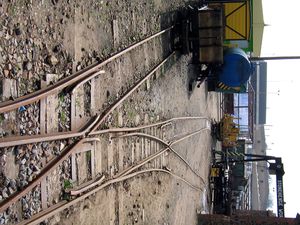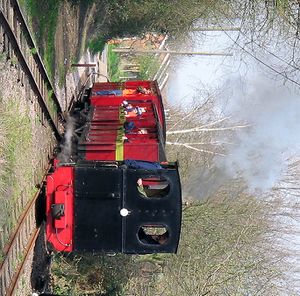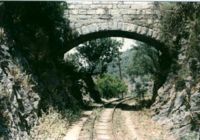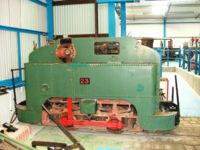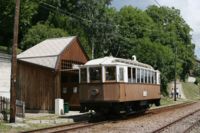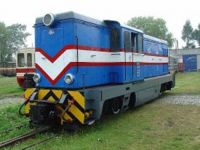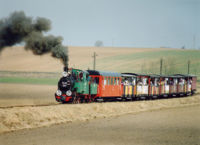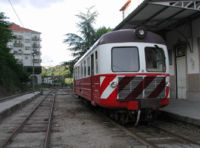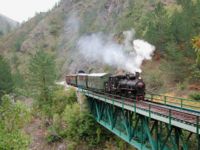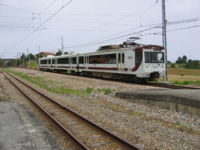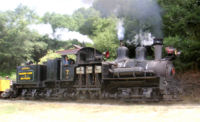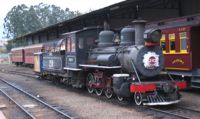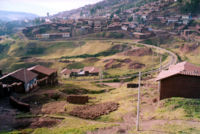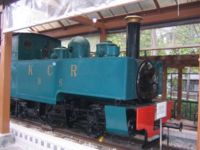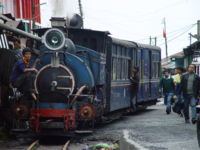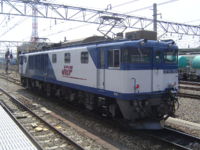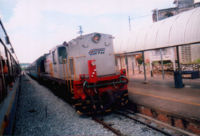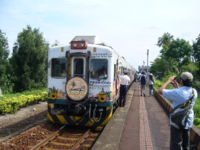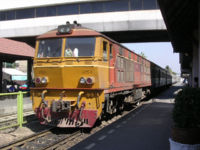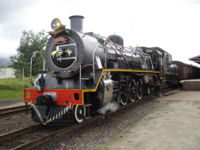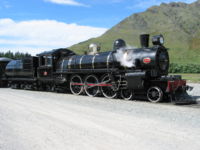Narrow gauge

Narrow gauge railways have a gauge narrower than the 1,435 mm (4 ft 8½ in) of standard gauge railways. Most existing narrow gauge railways have gauges of 3 ft 6 in (1067 mm) or less. Since they can accommodate smaller radius curves, narrow gauge railways can be substantially cheaper to build, equip, and operate than standard-gauge railways, particularly in mountainous terrain. The lower costs of narrow gauge railways mean they are often built to serve industries and communities where the traffic potential would not justify the costs of building a standard gauge line. Narrow gauge railways also have specialized use in mines and other environments where their smaller loading gauge is an advantage. On the other hand, standard gauge railways generally have a greater haulage capacity and allow greater speeds than narrow gauge systems.
| Rail gauge |
|---|
| Broad gauge |
| Standard gauge |
| Scotch gauge |
| Narrow gauge |
| Dual gauge |
| Break-of-gauge |
| Rail tracks |
| Tramway track |
| List of Rail Gauges |
| [edit] |
Historically, many narrow-gauge railways were built as part of specific industrial enterprises and were primarily industrial railways rather than general carriers. Some common uses for these industrial narrow-gauge railways were mining, logging, construction, tunnelling, quarrying, and the conveying of agricultural products. Extensive narrow gauge networks were constructed in many parts of the world for these purposes. Significant sugarcane railways still operate in Cuba, Fiji, Java, the Philippines and in Queensland in Australia. Narrow gauge railway equipment remains in common use for the construction of tunnels.
The other significant reason for narrow gauge railways to be constructed was to take advantage of reduced construction costs in mountainous or difficult terrain, hence the national railway systems of countries such as Indonesia, Japan and New Zealand are primarily or solely narrow gauge. Non-industrial narrow gauge mountain railways are or were common in the Rocky Mountains of the USA and the Pacific Cordillera of Canada, in Mexico, Switzerland, the former Yugoslavia, Greece, India, and Costa Rica. Another country with a notable national railway built to narrow gauge is South Africa where the "Cape gauge" of 3 ft 6 in (1067 mm) is the most common gauge.
History of narrow-gauge railways
The earliest recorded railway is shown in the De re metallica of 1556, which shows a mine in the Czech Republic with a railway of approximately 2 ft (610 mm) gauge. During the 16th century railways were mainly restricted to hand-pushed narrow gauge lines in mines throughout Europe. During the 17th century mine railways were extended to provide transportation above ground. These lines were industrial, connecting mines with nearby transportation points, usually canals or other waterways. These railways were usually built to the same narrow gauge as the mine railways they developed from. [1]
Advantages of narrow gauge
Narrow-gauge railways cost less to build because they are lighter in construction, using smaller cars and locomotives as well as smaller bridges, smaller tunnels and tighter curves. Narrow gauge is thus often used in mountainous terrain, where the savings in heavy civil engineering work can be substantial. It is also used in very sparsely populated areas where the potential demand is too low for the building of broader gauge railways to be economically viable. This is the case in most of Australia and Southern Africa, where extremely old soils can support only population densities too low for standard gauge to be viable.
There are many narrow gauge street tramways, particularly in Europe where narrow streets created a requirement for trams with narrow bodies. A notable example of this is the tramway in Linz, Austria.
Extensive narrow gauge railway systems served the front-line trenches of both sides in World War I. After the end of the war the surplus equipment from these railways created a small boom in the building of narrow-gauge railways in Europe.
For temporary railroads that will be removed after a short-term need, such as for construction, the logging industry and the mining industry, a narrow gauge railroad is substantially cheaper and easier to install and remove. However, this use of railroads is almost extinct thanks to the capabilities of modern trucks.
In many countries narrow gauge railroads were built as "feeder" or "branch" lines to feed traffic to more important standard gauge railroads, due to their lower construction costs. The choice was often not between a narrow gauge railroad and a standard gauge one, but between a narrow gauge railroad and none at all.
Disadvantages of the narrow gauge
Narrow gauge railroads generally cannot interchange equipment, particularly freight and passenger cars, with the standard gauge railroads they link with, unless they use variable gauge axles. The means that narrow-gauge lines have a built-in cost of transshipping people and freight to the mainline railway system. The cost of transshipment is a substantial drain on the finances of a small railroad because it involves expensive and time consuming manual labor or substantial capital expenditures. Some bulk commodities, such as coal, ore and gravel, can be mechanically transshipped, but this still incurs time penalties and these mechanical devices are often complex to maintain.
A modern solution to this problem is the roll-block system. Although successfully deployed in countries such as Germany, this technique came too late for the majority of narrow gauge lines.
The problem of interchangeability is less serious for countries that have a large system of narrow gauge lines, such as those in New Zealand, northern Spain, South Africa and the Australian island state of Tasmania.
Narrow gauge lines were very vulnerable to competition from trucks. The railroads' advantage has always been economy of scale and distance, and the transshipment requirement removed that. Trucks have no such a transshipment problem and are more flexible in operation.
Other problems with narrow gauge railroads is that they lacked room to grow - their cheap construction was bought at the price of being engineered only for their initial traffic demands. While a standard or broad gauge railroad could more easily be upgraded to handle heavier, faster traffic, many narrow gauge railroads were impractical to improve. Speeds and loads hauled could not increase, so traffic density was significantly limited.
Narrow gauge railroads can be built to handle increased speed and loading, but at the price of removing most of the narrow gauge's cost advantage over standard or broad gauge.
Because of the reduced stability of narrower gauge, narrow gauge trains are not able to run at nearly the same high speeds as those networks with broader gauges unless the tracks are aligned with greater precision. However in Japan and Queensland, Australia, recent permanent way improvements have allowed trains on 1067 mm gauge tracks to run at 160 km/h (100 mph) and higher. Queensland Rail's tilt train is presently the fastest train in Australia, despite the gauge it runs on. Standard gauge or broad gauge trains can run at up to 320 km/h (200 mph); this is most evident in the case of the Japanese Shinkansen, a network of standard gauge lines built solely for high speed rail in a country where narrow gauge is the predominant standard.
Exceptions to the rule
The heavy duty 3 ft 6 in (1067 mm) narrow gauge railways in South Africa and Queensland, Australia, show that if the track is built to a heavy-duty standard, a performance almost as good as a standard gauge line is possible. Narrow-gauge lines are more limited in the capacity and stability of their trains. Similarly, standard and broad gauge lines can be built cheaply to light railway standards, with trains operating at lower speeds and with lower capacities, and these lines were often built instead of narrow gauge railways.
Gauges used
There are many narrow gauges in use or formerly used between 15 in (381 mm) gauge and 4 ft 8 in (1422 mm) gauge. They fall into three broad categories
Medium gauge railways
The wider narrow gauges are the more common; in those parts of the world where the railroads were built to British standards, this meant most commonly a gauge of 3 ft 6 in (1067 mm), while those built to American standards were normally 3 ft (914 mm). Railways built to European metric standards were most commonly of 1 m (3 ft 3 3/8 in) and 900 mm (2 ft 11 1/2 in) gauge.
These larger narrow gauges are capable of hauling most traffic with little difficulty and are thus suitable for large-scale "common carrier" applications, although their ultimate speed and load limits are lower than for standard gauge.
Railways built on gauges between 3 ft (914 mm) and 4 ft 8 in (1422 mm) are sometimes referred to as "medium-gauge" railways
Two-foot gauge railways
The next natural "grouping" of narrow gauge railroads covers the spread from just below 2 ft (610 mm) to just below 3 ft (914 mm), although the majority are between 2 ft (610 mm) and 760 mm (2 ft 6 in). These lightweight lines can be built at a substantial cost saving over medium or standard gauge railways, but are very restricted in their carrying capacity. The majority of these were built in mountainous areas and most were to carry mineral traffic from mines to ports or standard gauge railroads. Many were industrial lines rather than common carriers, though there were exceptions such as the extensive 760 mm (2 ft 6 in) lines built in the former Austro-Hungarian Empire, and the "Maine two footer" lines in New England. The most common metric gauges in this group are 760 mm (2 ft 6 in) and 750 mm (2 ft 51⁄2 in).
Minimum gauge railways
Gauges below 600 mm were rare, but did exist. In Britain, Sir Arthur Heywood developed 15 in (381 mm) gauge estate railways, while in France Decauville produced a range of industrial railways running on 400 mm (153⁄4 in) and 500 mm (1 ft 73⁄4 in) tracks, most commonly in such restricted environments such as underground mine railways. A number of 18 in (457 mm) gauge railways were built in Britain to serve ammunition depots and other military facilities, particularly during the First World War.
Narrow gauge railways under 1 ft 103⁄4 in (578 mm) gauge are known as minimum gauge railways.
Narrow gauge worldwide
Europe
Austria
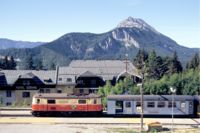
The first railway in Austria was the narrow gauge line from Gmunden in the Salzkammergut to Budweis, now in the Czech Republic, this was 1106 mm (431⁄2 in or 3 ft 71⁄2 in) gauge. Some two dozen lines were built in 2 ft 6 in (762 mm) gauge, a few in meter gauge. The first was the Steyrtalbahn. Others were built by provincial governments, some lines are still in common carrier use and a number of others are preservation projects. The tramway network in Innsbruck is also metre gauge, in Linz the rather unusual gauge of 900 mm is in use.
Bulgaria
In the beginning of the 20th century there were many narrow gauge railways in Bulgaria but only 245 km remain.
Belgium
The Vicinal or Buurtspoor were a system of narrow gauge local railways or tramways covering the whole country and having a greater routage than the mainline railway system. They were 1 m (3 ft 33⁄8 in) gauge and the system included electrified city lines as well as rural lines using steam locomotives and railcars; half of the system was electrified. Many lines carried freight. Only the coastal line and two routes near Charleroi are still in commercial use, four museums hold significant collections of former SNCV/NMBS rolling stock, one of which is the ASVi museum in Thuin. The tramway networks in Antwerp and Gent are also metre gauge.
Czech Republic
Several lines were built in the nineteenth century. The most notable lines are Obrataň-Jindřichův Hradec-Nová Bystřice and Třemešná ve Slezsku-Osoblaha, that are still in operation.
France
The French National Railways used to run a considerable number of 1 m (3 ft 33⁄8 in) lines, a few of which still operate mostly in tourist areas, such as the St Gervais-Vallorcine (Alps) and the "Train Jaune" (yellow train) in the Pyrenees. The original French scheme was that every sous-prefecture should be rail connected. Extensive near 0.60m (1 ft 11½ in) gauge lines were also built for the sugar-beet industry in the north often using ex-military equipment after the First World War. Decauville was a famous French manufacturer of industrial narrow-gauge railway equipment and equipped one of the most extensive regional 0.60m (1 ft 11½ in) narrow gauge railway, the Chemins de Fer du Calvados. Corsica has a narrow gauge network of two lines following the coast line, that are connected by one line crossing the island through highly mountaineous terrain.
Germany
A number of narrow-gauge lines survive, largely as a consequence of German reunification, in the former East Germany where some of them form part of the public transport system as active commercial carriers. Most extensive of those still employing steam traction is the Harz mountain group of metre-gauge lines, the Harzer Schmalspurbahnen. Other notable lines are the Zittau-Oybin-Jonsdorf line in Saxony, the Mollibahn and the Rügensche Kleinbahn on the Isle of Rügen on the Baltic coast and the Radebeul-Radeburg line in the suburbs of Dresden. Although most rely on the tourist trade, in some areas they provide significant employment as steam traction is particularly labour intensive.
Greece
The Peloponnese narrow gauge network length is about 914 km. Of this, 1 m (3 ft 33⁄8 in) gauge is used for 892 km. This is the network that connects major cities in the Peloponnese. The remaining 22 km form the Diakofton-Kalavryta rack railway, which uses 750 mm (2 ft 51⁄2 in) gauge. The Peloponnese network has suffered various setbacks, ranging from the abandonment of entire lines (such as the Pyrgos-Katakolon railway) to inefficient management on part of the public Greek railway operator, OSE, which resulted in poor quality of services and rolling stock). Currently major restoration works are carried out, which have resulted in parts of the line having been closed. Additionally, the reactivation of certain lines that were closed down during the latter half of the 20th century is planned, mainly the Pyrgos-Katakolon line and in parts of western Greece (around Agrinion and Messologgi). Another small railway that uses narrow gauge 600 mm (1 ft 111⁄2 in) is the Mt. Pelion railway, originally from Volos to Milies. Currently parts of the line are operational during the summer, mainly for excursions. There was also a narrow gauge network in Thessaly. This has now been abandoned, and trains use standard gauge tracks. However, the old narrow gauge tracks remain largely in place, so that it is theoretically possible for special excursion trains to use them.
Ireland
Several 3 ft (914 mm) narrow gauge systems once existed in Ireland. In County Donegal an extensive network existed, with two companies operating from Derry - the Londonderry & Lough Swilly Railway (L&LSR) and the County Donegal Railways (CDRJC). Well known was the West Clare Railway - in County Clare, which saw diesel locomotion before closure. The Cavan & Leitrim Railway (C&LR) operated in what is now the border area of County Cavan and County Leitrim. Some smaller narrow gauge routes also existed in County Antrim and also County Cork - notably the Cork Blackrock & Passage Railway.
Apart from small heritage venues, the Irish narrow gauge today only survives in the bogs of the Midlands as part of Bord na Móna's extensive industrial network for transporting harvested peat to distribution centres or power plants.
See also: History of rail transport in Ireland
Italy
Narrow gauge railways in Italy are (or were) mainly build with 950 mm gauge, with some 1 m (3 ft 33⁄8 in) gauge lines and with a few other gauges.
In Sardinia, a network of narrow-gauge lines (950 mm) was built, to complement the standard-gauge main network which covered the main cities and ports. The lines were Siliqua-San Giovanni Suergiu-Calasetta (dismantled), Iglesias-Monteponi-San Giovanni Suergiu (dismantled), Monteponi-Portovesme (dismantled), Cagliari-Mandas-Isili-Sorgono, Mandas-Gairo-Arbatax, Gairo-Jerzu (dismantled), Isili-Villamar-Villacidro (dismantled), Villamar-Ales (dismantled), Macomer-Bosa (dismantled between Bosa Marina and Bosa), Macomer-Tirso-Nuoro, Tirso-Ozieri (dismantled), Sassari-Alghero, Sassari-Sorso, Sassari-Tempio Pausania-Luras-Palau, Luras-Monti (dismantled). Of the lines which are still present, only Cagliari-Mandas-Isili, Sassari-Alghero, Sassari-Sorso and Macomer-Nuoro still carry regular passenger services, operated by Ferrovie della Sardegna (Railways of Sardinia). The others only operate a scenic tourist service known as Trenino verde (small green train).
In Sicily, too, some narrow-gauge lines (950 mm) operated, the most important of which was the Castelvetrano-Porto Empedocle. All those lines are closed.
Between Naples and Sorrento, around the base of Mt. Vesuvius, the narrow-gauge (950 mm) Circumvesuviana railway operates frequent services on narrow gauge tracks.
Isle of Man
Both main railways in the Isle of Man are of 3 ft (914 mm) gauge. The Isle of Man Steam Railway to the southwest is operated largely as a tourist attraction but the Manx Electric Railway to the northeast is a commercially operated railway system though its operation is closer to that of a tramway than a railway. The Snaefell Mountain Railway, climbs the island's main peak and has a gauge of 3 ft 6 in (1067 mm); it is the sole operating Fell Incline Railway System in the world.
Lithuania
158.8 km of 750 mm narrow-gauge lines remain, although only 68.4 km of them (serving five stations) are regularly used, employing 12 locomotives. They are included in the Registry of Immovable Cultural Heritage Sites of Lithuania.
Norway
In Norway, a number of main lines were in the 19th century built with narrow gauge, 3 ft 6 in (1067 mm), to save cost in a sparsely populated mountainous country. This included Norway's first own long-distance line, Rørosbanen, connecting Oslo and Trondheim, 1877. Some secondary railways also had this gauge. These railways have been rebuilt to standard gauge or closed down. Some private railways had 750 mm (2 ft 51⁄2 in) and 1 m (3 ft 33⁄8 in). A few railways partly still are operated as museum railways, specifically Thamshavnbanen, Urskog-Hølandsbanen and Setesdalsbanen. The tramway in Trondheim, Gråkallbanen is also narrow gauge.
Poland
There are hundreds of kilometres of 600 mm, 750 mm, 785 mm, and 1 m (3 ft 33⁄8 in) narrow-gauge lines in Poland. The one-metre lines are mostly found in the northwest part of the country, in Pomerania, while 785 mm lines are found only in the Upper Silesia region. 750 mm is the most commonly used narrow gauge; it is used, for example, in the Rogów Narrow Gauge Railway (Rogowska Kolej Wąskotorowa). Some narrow-gauge lines in Poland still operate as common carriers (such as the lines operated by SKPL, the Association of Local Railway Transport)[1], while others survive as tourist attractions. One of the finest of the latter is the 600 mm narrow-gauge railway (Żnińska Kolej Powiatowa) running from Żnin via Wenecja (Polish Venice) and famous Biskupin to Gąsawa in the Pałuki region. The Pałuki's traditions date back to July 1894 when the first two lines were opened. In the past, there have also been 760 mm, 800 mm, and 900 mm lines. A 900 mm recreational line, 4.2 km long, still operates in the Amusement-Recreation Park in Chorzów, Upper Silesia. Some of Polands narrow-gauge railways are maintained by fan-volunteers; one organization dedicated to saving narrow-gauge railways is the FPKW, the Polish Narrow Gauge Railways Foundation [2].
Portugal
Portugal has 178 km of 1 m (3 ft 33⁄8 in) gauge railroad. At least one passenger service known as the Linha do Tâmega is in operation. It runs between Livração and Amarante in the District of Porto and runs near the River Tâmega.
Russia
In Russia, narrow gauge is most often 750 mm (2 ft 51⁄2 in) or 1 m (3 ft 33⁄8 in). 3 ft 6 in (1067 mm) gauge is found only in the southern part of Sakhalin, where railroads were built by the Japanese. A complete list of Russian and other ex-Soviet Narrow Gauge railways.
Slovakia
Bratislava and Kosice use 1 m (3 ft 33⁄8 in) gauge for trams. Railways, however use standard gauge 1,435 mm (4 ft 8½ in) making tram and railways networks incompatible with each other. There is a discussion regarding transforming Bratislava's tram gauge to standard gauge to allow trams to use the railways tracks to increase transportation capabilities of Bratislava's public transportation system. The most notable tourist lines in operation are the 760 mm (2 ft 6 in) gauge Čiernohorská železnica and Oravsko-kysucká lesná železnica - Vychylovka.
Serbia
The narrow-gauge railway line at Mokra Gora on the slopes of Serbian mountain Zlatibor climbs a 300 metre ascent using an unusual loop in the form of the figure eight – the popular "Šargan Eight".
Spain
In Spain there is an extensive system of 1 m (3 ft 33⁄8 in) gauge railways, in the north of the country, operated by FEVE (Ferrocarriles Españoles de Vía Estrecha, Spanish narrow gauge railways) and EuskoTren (Eusko Trenbideak, Basque Railways). At the centre of this system is a metre gauge line which runs for 650 km (400 miles) along the entire length of Spain's north coast. FEVE and EuskoTren form the longest narrow gauge network in Europe. Also near Madrid, on the mountain range of Guadarrama runs a mountain train through a short but extremely sinuous track, operated by Renfe. Separate metre gauge railways are operated by the FGC (Ferrocarrils de la Generalitat de Catalunya, Catalan regional government railways) from Barcelona to Manresa and Igualada, the FGV (Ferrocarrils de la Generalitat Valenciana, Valencian regional government railways) around the city of Valencia, and the SFM (Serveis Ferroviaris de Mallorca) on the island of Majorca. Also on the island of Majorca, the FS (Ferrocarril de Sóller) operates a 3 ft (914 mm) gauge electrified railway and connecting tramway. Also the Euskotran in Bilbao, which is not a "light rail", is unusual in new tramway and light rail systems opened in the last twenty-five years in having adopted metre gauge. Metro Bilbao started on a ET/FV (now EuskoTren) Tren track and has a metre gauge.
Sweden
Sweden once had some fairly extensive narrow gauge networks, but most narrow gauge railways are now closed. Some were converted to standard gauge (the latest one the line between Berga and Kalmar in the 1970s) and some remains as heritage railways. The most common narrow gauge, 891 mm (3 Swedish feet), existed only in Sweden. A smaller 3 ft 6 in (1067 mm) gauge network existed, and 600 mm (1 ft 111⁄2 in) gauge was used mostly by smaller, industrial railroads.
The only commercial narrow gauge railway left is the Roslagsbanan suburban railway in north-eastern Stockholm (891 mm gauge). The longest other remaining narrow gauge railway is the 891 mm line between Åseda, Hultsfred and Västervik. 70 km between Hultsfred and Västervik is served by tourist trains in the summer, including 4 km of dual gauge track).
Sweden also had the unique 1093 mm gauge Köping-Uttersberg-Riddarhyttan Railway.
Switzerland
Switzerland boasts an extensive network of metre gauge railways, many of which interchange traffic (most prominent is the Rhaetian Railway). They are concentrated in the more heavily mountainous areas. The Jungfraubahn terminates at the highest station in Europe. Dual gauge (combined metre- and standard gauge trackway) also exists in many areas. Also, nearly all street tramways in Switzerland were and still are also metre gauge.
United Kingdom

The United Kingdom once had a large number of narrow gauge railways. The first locomotive-hauled railway in the world was the narrow gauge Penydarren Tramway in south Wales. Most of the lines were originally built to haul minerals or agricultural products over short distances, though many also carried passengers. The longest passenger line was the combined Welsh Highland and Ffestiniog railways at 45 miles.
Only a few of these lines survive as commercial common carriers. The great majority of the remaining narrow gauge lines operate purely as tourist attractions, and a number of new narrow gauge tourist lines have been built in recent years. The sole passenger-carrying exception is the Glasgow Subway, an underground metro line that operates on a 4 ft (1219 mm) gauge. The Talyllyn Railway holds the distinction of being the first railway in the world of any gauge to be run entirely by volunteers. In addition a few private industrial narrow gauge railways remain, mainly serving the coal and peat extraction industries.
Amongst the most well-known narrow gauge lines in Britain are the Ffestiniog - now the oldest independent railway company in the world - the Vale of Rheidol, and the Welshpool & Llanfair in Wales, and the Lynton & Barnstaple in England. Unique amongst British railways is the rack-and-pinion Snowdon Mountain Railway which climbs to just below the summit of Wales' highest peak.
North America
Canada
Although many railways of central Canada were initially built to a broad gauge, there were several railways on Canada's Atlantic coast which were built as individual narrow gauge lines. Several early railways in Ontario were also built to a narrow gauge in the 1860s and 1870s; most were quickly converted to standard gauge.The 3 ft 6 in (1067 mm) Prince Edward Island Railway was built 1871 but converted to standard gauge when Prince Edward Island joined Canada in 1873.
Construction on the 3 ft 6 in (1067 mm) Newfoundland Railway was built between 1881 and 1898. It became part of the Canadian National Railways (CNR) when Newfoundland became part of Canada in 1949. In 1987, Canada deregulated its railway industry and allowed railways to abandon money-losing lines. The Newfoundland Railway was abandoned in 1988 and the P.E.I. Railway in 1989.
Various mining and industrial operations in eastern, central and western Canada have also operated narrow gauge railways. The only narrow gauge system still in operation in the country is the 3 ft (914 mm) gauge White Pass and Yukon Route that reopened in 1988 to haul tourists from cruise ships docking at Skagway, Alaska through White Pass on the International Boundary to Bennett, British Columbia.
Mexico
Various narrow gauge lines operated around Mexico City. A famous one operated in Morelos State. There were also dozens of private narrow gauge lines built to service the mining district.
The Yucatán region of Mexico has a network of narrow gauge lines, established before the region was linked by rail to the rest of Mexico in the 1950s. Only the main line connecting Merida to central Mexico has been widened to standard gauge.
United States
Many narrow gauge railways were built in the United States. The most extensive and well known systems were the 3 ft (914 mm) gauge lines through the Rocky Mountain states of Colorado and New Mexico. For a while the majority of the railway mileage in these states was narrow gauge.
In the New England state of Maine, a network of 2 ft (610 mm) gauge lines served the rural economy between the 1870s and 1940s.
Across the US, industrial narrow gauge railways were used, perhaps the best known being the 3 ft (914 mm) gauge logging lines of the western states of Oregon and California.
Today a few lines survive as heritage railways and tourist attractions.
Central America
Guatemala
- Ferrovías Guatemala, 3 ft (914 mm) gauge, Ferrovías Guatemala
El Salvador
El Salvador ran 3 foot gauge steam trains into the 1970s. How much of this survived a civil war, earthquake and hurricane is unknown.
Panama
Mule Locos haul ships through the locks in the Panama Canal.
South America
Metre and 3 ft (914 mm) gauge lines are found in South America. Some of the 1 m (3 ft 33⁄8 in)-gauge lines cross international borders, though not as efficiently as they might.
Argentina
Meter gauge railways are found in the northern half of the country. The Old Patagonian Express (La Trochita) was a 402km-long 0.75m narrow gauge railway in the Andean foothills of [atagonia, now running on a small portion of its original length. The Southern Fuegian Railway (End of the World Train) on a 0.6m track is considered the southernmost operating railway in the world.
Bolivia
All railways in Bolivia are meter gauge.
Brazil
In Brazil, almost all the lines are 1 m (3 ft 33⁄8 in) gauge, with the exception of a few lines in the states of São Paulo, Minas Gerais, Rio de Janeiro and Mato Grosso. A network of 760 mm (2 ft 6 in) gauge lines once operated in Minas Gerais, centered around the city of São João do Rei. This network at one time had over 250 km of railway in operation, but only about 13 km remain in operation as a steam powered tourist railway. Other small narrow gauge lines include the Rio de Janeiro streetcar (Bonde Santa Tereza), with approximately 13 km of 1100 mm gauge, and a very short industial railway near Bertioga built to 800 mm gauge. A number of industrial (a two foot gauge Portland Cement line near São Paulo, for example) and agricultural (rubber plantations, sugar plantations, logging) railways also existed in Brazil in a number of narrow gauges, but few if any survive today.
Chile
Meter gauge railways are found in the northern half of the country. The Ferrocarril de Antofagasta a Bolivia was originally built to 2 ft 6 in (762 mm) gauge, as were a number of mining and nitrate railways.
Colombia
Most all railways in Colombia are 3 ft (914 mm) gauge.
Costa Rica
Costa Rican railways are 3 ft (914 mm) gauge
Ecuador
The railways in Ecuador are 3 ft (914 mm) gauge. This is a famous route, the one that zig zags past the chilling canyon of the Devil's Nose. Floods, landslides and government neglect have put this operation in doubt, but it has, until recently, been used by tourist charters and coffee advertisements. Two Baldwin locomotives are ready to work, depending on track and traffic.
Peru
Some railways in Peru are 3 ft (914 mm) gauge, but in 2006 are to be converted to standard gauge.
Asia
China
The 1 m (3 ft 33⁄8 in) gauge Kunming-Hekou Railway (previously known as Sino-Vietnamese Railway) was built by French colonists between Vietnam and China. It is now inoperative for passengers due to landslides but does have freight services. This railway, opened in 1910, had a 2 ft (610 mm) gauge branch line from Jijie to Gejiu which operated 0-10-0 tender locos built by Alco[2]. The metre gauge section was originally administered in more or less the same way as the Indochinese networks, and it was physically possible for through trains to be run from Kunming to Singapore, as metre gauge was used in both these countries. During the Japanese occupation Japanese National Railways Class 9600 2-8-0 locomotives were shipped to aid their invasion, and after the completion of the "death railway" it was possible for a time for through traffic to Burma and further, the Indian metre gauge network. This is now impossible as sections of this railway have been destroyed during the conflicts since World War II[2].
Metre gauge railways were popular in China in several regions before the 1949 communist takeover. The railway from Shijiazhuang to Taiyuan was opened at the tun of the century. It was French and Belgian controlled, since it was a feeder of the Belgian controlled Peking-Hankow Railway. To minimise costs, it was built to the the same 1 m (3 ft 33⁄8 in) gauge of the Kunming Hekou Railway, with the hope that the latter could be extended to Shanxi province and so join the two railways, forming a new sphere of influence for the French. Although this did not materialise, as a result, the Railway from Datong to Pukou, opened in 1933, which was funded by the Japanese and controlled by the Shanxi warlord, Yan Xishan, and which connected the Shijiazhuang - Taiyuan Railway at Taiyuan, had to be built to metre gauge as well. While the Shijiazhung - Taiyuan Railway (sometimes known as Zheng Tai Railway) was built to the nature of a light railway and used rolling stock built in France and Belgium, the Datong - Pukou Railway (Tong Pu Railway) used rolling stock built by Japanese companies, even withdrawn old Japanese National Railways or Imperial Taiwan Railway stock. When the Japanese invaded the Shanxi and Hebei provinces during the Sino-Japanese War, these two railways were converted to standard gauge[2].
In many rural or suburban areas, metre gauge railways were built to transport agricultural produce. Such was the case of two light railways east of Pudong, Shanghai. They were isolated systems using small tank engines, like 4-4-2Ts. Later, experiments were made with gasoline railcar and trailer sets having Ford engines. They were closed in the 50s and 70s respectively and replaced by bus services[2].
In Manchuria, lumber industries built narrow gauge railways into the forests. These used Russian and Japanese locomotives, copied from Soviet or Eastern European designs. Now most of them have disappeared. These railways mostly use a gauge of 2 ft 6 in (762 mm). In many provinces 2 ft 6 in (762 mm) gauge light railways were used for mines and prominently in Henan and Sichuan they were used for rural transportation, ironically most of them were built in an era when most European light railways had started to dwindle in favour of roads. One light railway in Sichuan is being preserved as China's first hertiage steam railway[2].
There were several 3 ft 6 in (1067 mm) gauge military railways in Manchuria during the Russo-Japanese War. These Japanese military railways - which includes a section converted from the 5ft broad gauge Chinese Eastern Railway - used Japanese National Railways stock and were quickly converted back to standard gauge after the war to facilitate through traffic with the British controlled Peking Mukden Railway, which was standard gauge. As a result the South Manchurian Railway, a creation of the Japanese Kwantung Army, was standard gauge[2].
Hong Kong
The Kowloon-Canton Railway (now East Rail) was originally partially laid to 2 ft (610 mm) and 3 ft (914 mm) gauge during its construction, and the latter was proposed to be its gauge since the tunnel could only accommodate 3 ft (914 mm) gauge if the line was to be double track throughout. However it was built to standard gauge and was single track, retaining space at places for later expansion. The now-defunct Sha Tau Kok Railway, built in 1911 and closed in 1928, constructed of the same materials used for constructing the main line, was 2 ft (610 mm) gauge. The famous Hong Kong Tramways uses are 3 ft 6 in (1067 mm) gauge. The MTR uses a gauge of 1432 mm, 3 mm narrower than the standard gauge. Originally it was to be standard gauge but when the link between the KCR and MTR at Kowloon Tong fell into disuse due to the difference in the choice of voltage for their respective electrification plans, the latter favoured a narrower gauge for technical reasons. This has proven to be an impediment of the proposed merger between the two systems[2].
The haematite mine at Ma On Shan used an electric internal railway network of 2 ft 6 in (762 mm) gauge, but closed in 1975[2].
The Kowloon Godowns in Tsim Sha Tsui, before redevelopment in the 1970s, also had an extensive network of 2 ft (610 mm) gauge tracks using tiny hand-pushed 2-axle trucks. Similar systems existed elsewhere in Hong Kong. Railways believed to be metre gauge existed in Taikoo Dockyards and Whampoa Dockyards, though standard gauge is more probable for the latter, since it was connected to the main line network after 1937. A cement works in To Kwa Wan, north of the Whampoa dockyards, used a small internal narrow gauge system with jubilee track and wagons, but apart from a few aerial photographs available at the lands Department Mapping Office, there is little available information about this system[2].
During the reclamation of Kowloon Bay for the construction of the Kai Tack estates jubilee track and steam locomotives were used to convey spoil. This area became the Kai Tak Airport which has now been demolished[2].
India
India has a substantial narrow-gauge network, most of which uses the 1 m (3 ft 33⁄8 in) gauge. There are some lines that use a 2 ft 6 in (762 mm) gauge, and a few that use 2 ft (610 mm) gauge. These are what are known in India as "narrow gauge" (as opposed to "metre gauge") lines. About 17,000 km of route are metre-gauge in India.
In the 1990s, India concluded that cities on the metre-gauge network have a second-rate train service, and is now converting most of the metre-gauge network to broad gauge as Project Unigauge - the advantages of uniformity and interoperability were judged to outweigh any other possible benefits arising from the use of diverse gauges.
In 1999 the Darjeeling Himalayan Railway (sometimes called the Darjeeling "Toy Train") was officially designated as a UNESCO World Heritage Site. It is a 2 ft (610 mm) gauge narrow-gauge railway that runs from Siliguri to Darjeeling in the state of West Bengal in India. The railway travels through spectacular mountain scenery and uses several unusual civil engineering techniques to gain the necessary height including several switchbacks, and spirals including the famous double loop at Agony Point. The line was inspired by the earlier success of the 1 ft 111⁄2 in (597 mm) gauge Ffestiniog Railway in North Wales. Until recently all trains on the railway were powered by steam locomotives; however in 2001 two modern diesel engines were built for the line and now most trains are diesel hauled.
Indonesia
Indonesia had large numbers of narrow-gauge railways supporting industry, mainly sugar cane plantations in Java. In recent years, sugar cane production in Java has been declining and the railways are now largely closed or used for tourism.
Most of the current active railways in Indonesia use the Cape gauge (1067 mm).
Japan
Except for the high-speed Shinkansen lines, all of Japan Railway group's network is narrow-gauge, built at 3 ft 6 in (1067 mm). Some companies, such as Keisei Electric Railway, Keihin Electric Express Railway, Tokyo Metro's Ginza Line and Marunouchi line, use standard gauge. Keio Electric Railway, Toei Shinjuku Line and Tokyo and Hakodate tramways use 4 ft 6 in (1372 mm) gauge. There are some dual gauge lines which allow Shinkansen trains to travel on narrow-gauge branches.
Malaysia
Keretapi Tanah Melayu the main railway operator in Malaysia, uses metre gauge for the main west and east coast intercity lines. Narrow gauge is also used for KTM Komuter, the country's Commuter Rail service, which links Kuala Lumpur with neighbouring suburbs. However, standard gauge is used by the newer light rail operators in Kuala Lumpur city (Putra LRT, Star LRT, KLIA Transit, and KLIA Ekspres).
In Sabah, the North Borneo Railway ("Keretapi Negeri Sabah") runs a metre-gauge line from Kota Kinabalu up to Tenom in the Crocker Ranges, via Beaufort. Steam trains are also used in this route.
Philippines
Except for the Light Rail Transit (LRT) and Metro Rail Transit (MRT) systems in Metro Manila, which have both been constructed to the international standard gauge, the Philippine National Railways ("PNR") uses the "Cape Gauge" of 3 ft 6 in (1067 mm). The PNR currently opertes only one line: from Manila to the southern Luzon city of Legaspi. Until the 1980s a more extensive network existed going as far north as San Fernando in La Union province. There are plans to restore the La Union line and to build new lines connecting Manila to Batangas and the international airport.
There are also a number of industrial narrow gauge steam railways operating in the sugar cane industry. These are concentrated on the islands of Negros and Panay. The Visayas region is the main center for the sugar cane lines; some of the mills, such as La Carlotta Milling in Negros, run charter trains for tourists. Abandoned lines exists on the islands of Cebu, abandoned in the 1950s or 1960s, Mindanao, and Panay, closed in the 1990s. There are plans to restore the Panay Rail line which connects Roxas City with Iloilo.
Taiwan
Except for the high speed railway and the metro systems in Taipei and Kaohsiung, all of Taiwan's railway network is narrow gauge, built at 3 ft 6 in (1067 mm). The isolated east coast railways that used 2 ft 6 in (762 mm) gauge were converted to 3 ft 6 in (1067 mm) when the lines were linked to the west coast system.
A 2 ft 6 in (762 mm) narrow-gauge mountain railway stretches 72 km and connects the city of Chiayi to the mountain resort of Alishan. The line serves mainly as a tourist attraction and offers breathtaking mountain views.
On September 7, 2006, Taiwanese government declared a plan to update to the standard gauge system.[3]
Middle East
Until 1932 a narrow gauge train ran from Cairo through Palestine, Lebanon, Syria, Turkey, Persia (later Iran) and Iraq. The tracks and stations are mostly tourist sites, with some sections refurbished and run as a tourist attraction. The train was notorious for being slow, and failing to go uphill. An old joke told about Ahmed, riding on his donkey alongside the train, who meets his cousin Abdulla, sitting in the train. After a while Ahmed on the donkey says: Sorry, but I must hurry on.
Thailand
While the Northern Line was originally build as standard gauge, the line was regauged after 1919 and the State Railway of Thailand now operates entirely on meter gauge, including international through services to Malaysia. However, standard gauge is used by the Bangkok Skytrain and the Bangkok Metro.
Africa
Narrow-gauge railways are common in Africa, where great distances, challenging terrain and low funding have made the narrow gauges attractive. Many nations, particularly in southern Africa, including the extensive South African Railway network (Spoornet), use a 3 ft 6 in (1067 mm) gauge. Metre gauge is also common, as in the case of the Uganda Railway. There used to be extensive 2 ft (610 mm) and 600 mm (1 ft 111⁄2 in) gauge networks in countries such as Morocco, Congo, Angola, Namibia and South Africa, but these have mostly been dismantled.
Because Africa is divided into many countries, railways built by different governments tend not to link up with each other, each country's lines connecting its outlands with its own port. Incompatible gauges are therefore not obvious. For example, a link from Nigeria to Cameroon would join 3 ft 6 in (1067 mm) to 1 m (3 ft 33⁄8 in).
Eritrea
Further north, the Eritrean Railway is in the midst of resurrecting its 950 mm narrow gauge railway, a relic of its former Italian colonial days that was abandoned and heavily damaged during Eritrea's war of independence. Neighbouring railways (should they ever connect) are 3 ft 6 in (1067 mm) in Sudan and 1 m (3 ft 33⁄8 in) in Ethiopia.
Cameroon
During the First World War when Cameroon was a German possession, a network of 2 ft (610 mm) gauge Feldbahn railways were built. These eventually extended to around 150 km of track serving rubber and palm oil plantations. [3]
Morocco
A 2 ft (610 mm) gauge industrial railway served the lead mines at Monte Afra on the north coast. There was also a network of 1 m (3 ft 33⁄8 in) gauge railways. [3]
South Africa
Originally standard gauge, the railways of the then Cape Colony changed to narrow gauge 3 ft 6 in (1067 mm), sometimes known as Cape gauge, for cost-cutting reasons. However, with the development of a strong economy, with heavy export coal and iron ore traffic, South Africa, like Queensland, operates several narrow-gauge trains that outdo most standard gauge and all broad gauge trains. In fact, in 1989 the Sishen-Saldanha line set a world record by carrying the biggest train in history, 7.2 km long containing 660 wagons pulled by 15 locomotives and weighing 71,232 tonnes. [4] However, the proposed Gautrain railway between Johannesburg and Pretoria will operate on standard gauge, and will thus not be capable of using any of the country's existing rail network.
Australia
Prior to Australia's becoming an independent unified country in 1901, each of the six British colonies was responsible for rail transport infrastructure. Of the six, three (Queensland, Western Australia, and Tasmania) opted for narrow gauge railways. The other colonies (later states) opted for either standard gauge or broad gauge railways, maintaining only limited narrow gauge rail lines, except for South Australia, which wavered between narrow and broad. As a result of this legacy, Australian railways are a confusing mix of all three gauges. Over time most of the mainland lines of whatever gauge linked up, with inconvenient break-of-gauge stations where they met.
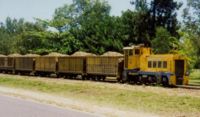
In 1865, the Queensland Railways was the first mainline narrow-gauge railway in the world [5]. Its tracks would eventually extend to around 9000 km. Queensland Rail operates the iconic QR Tilt Train, with a maximum speed of 165 km/h. This train currently holds the Australian Railway Speed Record of 210.7 km/h.
Queensland also has extensive sugar cane tramways of 2 ft (610 mm) gauge.
Following the success of the narrow gauge in Queensland, several narrow-gauge lines were built in South East Australia. From the 1920s onwards several of these were converted to broad gauge.
The Tasmanian rail network is now entirely narrow gauge.
Inspired by the success of the narrow gauge in Queensland, Western Australia adopted the same gauge. In the capital of Perth, there was the only narrow gauge tramway network of any considerable extent in mainland Australia. The final portion closed in 1958.
The Northern Territory adopted narrow gauge when it was still part of South Australia, and a North-South transcontinental line was planned from Adelaide to Darwin in the 1870s. In the event this line was never completed, and due to flood damage and lack of traffic, the narrow-gauge line was closed.
In New South Wales the large silver-lead mine at Broken Hill is only 30 km from the South Australian border, but separated by hundreds of kilometres of desert from the main NSW standard-gauge railway system. These mines are connected by a narrow-gauge railway.
Four common carrier lines in Victoria were built to the 2 ft 6 in (762 mm) narrow-gauge standard, to serve local farming and forestry communities. Sections of two lines (Belgrave to Gembrook and Thomson to Walhalla) have been restored as tourist railways.
New Zealand
Much like Australia, there was initially no uniformity in track gauges in New Zealand. This was because the construction of railways was undertaken by the various provinces of New Zealand rather than the central government. The Canterbury Provincial Railways opened New Zealand's first railway in 1863 and used a broad gauge of 5 ft 3 in (1600 mm), while Southland built the Bluff and Kingston Branches to 1,435 mm (4 ft 8½ in), and short segments of 1,435 mm (4 ft 8½ in) railway were also constructed in the Auckland and Northland Regions. Eventually, under the public works schemes of Premier Julius Vogel, the railways of New Zealand were made to adhere to a 3 ft 6 in (1067 mm) gauge. The first 3 ft 6 in (1067 mm) gauge railway in New Zealand was the Dunedin and Port Chalmers Railway, which opened on 1 January 1873. Today, the network connects all major New Zealand cities, and is around 4,000 km in length.
See also
External links
- Jane's World Railways (hard copy)
- Railroad Gauge Width
- Polish Narrow Gauge Railways
- Narrow Gauge Heaven - this site has a large photo gallery of narrow gauge railways
- Parovoz - Russian narrow gauge railways
- Narrow Gauge Railway Museum - based at the Talyllyn Railway in Wales.
- Cy Crumley ET&WNC Narrow Gauge Photo Collection
- Narrow Gauge in Austria
- Expo Narrow Gauge - model railway exhibition
References
- ↑ Whitehouse, Patrick and Snell, John B. (1984). Narrow Gauge Railways of the British Isles. ISBN 0-7153-0196-9.
- ↑ 2.0 2.1 2.2 2.3 2.4 2.5 2.6 2.7 2.8 2.9 A Picture Album of Steam Locomotives in China, 1876 - 2001. China Rail Publishing House. ISBN 7-113-04147-7.
- ↑ 3.0 3.1 Rowe, D. Trevor (1990). Two feet between the tracks. Plateway Press. ISBN 1-871980-03-8.
- ↑ UCW (2006). Quality Manual (PDF). UCW Partnership. Retrieved on 2006-10-31.
- ↑ Lee, Robert (2003). Potential railway world heritage sites in Asia and the Pacific. Institute of Railway Studies, University of York. Retrieved on 2006-10-31.
- P.J.G. Ransom. Narrow Gauge Steam - Its origins and worldwide development, Oxford Publishing Co., 1996, ISBN 0-86093-533-7
- P. Whitehouse, J. Snell. Narrow Gauge Railways of the British Isles, David & Charles, 1994, ISBN C-7153-0196-9
- Railroads of Colorado: Your Guide to Colorado's Historic Trains and Railway Sites, Claude Wiatrowski, Voyageur Press, 2002, hardcover, 160 pages, ISBN 0-89658-591-3
- Keith Chester. "East European Narrow Gauge" 1995
